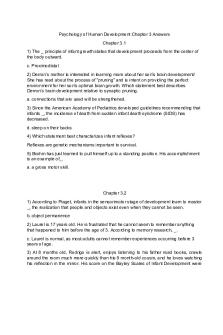Psychology of Human Development Chapter 3 Answers PDF

| Title | Psychology of Human Development Chapter 3 Answers |
|---|---|
| Author | Courtney Wilkison |
| Course | Psych Of Human Development |
| Institution | Florida Atlantic University |
| Pages | 2 |
| File Size | 47 KB |
| File Type | |
| Total Downloads | 71 |
| Total Views | 179 |
Summary
These are the Revel chapter 3 answers....
Description
Psychology of Human Development Chapter 3 Answers Chapter 3.1 1) The _ principle of infant growth states that development proceeds from the center of the body outward. c. Proximodistal 2) Derron’s mother is interested in learning more about her son’s brain development/ She has read about the process of “pruning” and is intent on providing the perfect environment for her son’s optimal brain growth. Which statement best describes Derron’s brain development relative to synaptic pruning. a. connections that are used will be strengthened. 3) Since the American Academy of Pediatrics developed guidelines recommending that infants _, the incidence of death from sudden infant death syndrome (SIDS) has decreased. d. sleep on their backs 4) Which statement best characterizes infant reflexes? Reflexes are genetic mechanisms important to survival. 5) Brahm has just learned to pull himself up to a standing position. His accomplishment is an example of_. a. a gross motor skill.
Chapter 3.2 1) According to Piaget, infants in the sensorimotor stage of development learn to master _, the realization that people and objects exist even when they cannot be seen. b. object permanence 2) Laurel is 17 years old. He is frustrated that he cannot seem to remember anything that happened to him before the age of 3. According to memory research, _. c. Laurel is normal, as most adults cannot remember experiences occurring before 3 years of age. 3) At 8 months old, Rodrigo is alert, enjoys listening to his father read books, crawls around the room much more quickly than his 9 month-old cousin, and he loves watching his reflection in the mirror. His score on the Bayley Scales of Infant Development were
quite high. Which of the following does Rodrigo’s high developmental quotient (DQ) indicate? d. Rodrigo is healthy, and appears to be developmentally ahead of his same-age peers. 4)/ Cierra sees a cat on the front porch, points to it and says to her mother “Kitty”. The fact that Cierra is using the word to imply a whole sentence- such as “Look at that kitty, momma!”-reflects the use of_. a. holophrases 5) Hekima is holding her infant daughter, Kazumi, and is speaking to her in short, simple sentences. Hekima is using a rather high-pitched voice and is often repetitive with her words. Which of the following best represents Hekima’s exchange with her daughter? b. infant-directed speech Chapter 3.3 1) Which of the following children is most likely to express stranger anxiety? d. Baird, an 18-month-old meeting a stranger at the front door of his home. 2) Two-year-old Elysa laughs at the reflection of herself in the mirror and then rubs off a smear of birthday-cake frosting on her cheek. Elysa’s displaying a keen sense of _. a. self-awareness. 3) Harlow’s parents are going out for the evening and you have been asked to babysit. When you are in the living room with his parents, Harlow is happy and contented. However, when they go back in their bedroom to finish getting dressed, he cries and is not comforted when you pick him up. As soon as his mother comes out, she picks him up and he immediately calms down. Harlow is exhibiting signs of a _ attachment. c. secure 4) An infant who expresses an inability to adjust to new surroundings, is irritable and shows signs of withdrawal when it is in a new environment would likely be characterized by Chess and Thomas as _. a. a difficult baby. 5) Which statement most accurately reflects the impact of child care outside the home? a. High-quality childcare outside the home does not adversely affect the security of infants attachment to their parents....
Similar Free PDFs

Chapter 3 Human Development
- 6 Pages

Principles OF Human Development
- 6 Pages

Nature of human development
- 11 Pages

STAGES OF HUMAN DEVELOPMENT
- 16 Pages

3 d Domains of Human Development
- 2 Pages

Chapter 5: Human Development notes
- 11 Pages
Popular Institutions
- Tinajero National High School - Annex
- Politeknik Caltex Riau
- Yokohama City University
- SGT University
- University of Al-Qadisiyah
- Divine Word College of Vigan
- Techniek College Rotterdam
- Universidade de Santiago
- Universiti Teknologi MARA Cawangan Johor Kampus Pasir Gudang
- Poltekkes Kemenkes Yogyakarta
- Baguio City National High School
- Colegio san marcos
- preparatoria uno
- Centro de Bachillerato Tecnológico Industrial y de Servicios No. 107
- Dalian Maritime University
- Quang Trung Secondary School
- Colegio Tecnológico en Informática
- Corporación Regional de Educación Superior
- Grupo CEDVA
- Dar Al Uloom University
- Centro de Estudios Preuniversitarios de la Universidad Nacional de Ingeniería
- 上智大学
- Aakash International School, Nuna Majara
- San Felipe Neri Catholic School
- Kang Chiao International School - New Taipei City
- Misamis Occidental National High School
- Institución Educativa Escuela Normal Juan Ladrilleros
- Kolehiyo ng Pantukan
- Batanes State College
- Instituto Continental
- Sekolah Menengah Kejuruan Kesehatan Kaltara (Tarakan)
- Colegio de La Inmaculada Concepcion - Cebu









